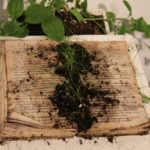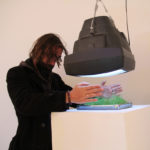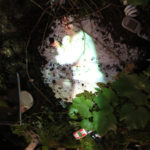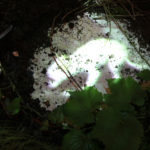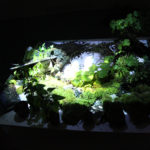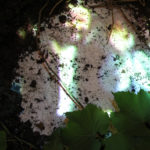The Phytophilous Initiative is a project of the Black Bag Media Collective that is engaged in developing our relationship with the earth by facilitating connections that bring us closer to plant life. From June 25th to July 30th, 2011 Liz Solo and Jesse Walker presented a gallery exhibit at Eastern Edge gallery in St. John’s featuring the results of studio work investigating communication with plant life. The show was paired in the gallery with Sandee Moore‘s (MB) Imaginary Gift.
These images are documentation of work from the exhibit by BBMC member Liz Solo.
Harlequin Romance/Plant Jam/Memory Table
This is a text written by Peter Duchemin about the Phytophilous Initiative:
Science and art, on rare occasions, are known to dance together. Often their affinity goes unrecognized, but in the words of Einstein: “Imagination is more important than knowledge. For knowledge is limited to all we now know and understand, while imagination embraces the entire world, and all there ever will be to know and understand”. There is a relationship of expansion and contraction, where creative thought opens a territory and rigorous experiment reveals forms and patterns within that territory. Reason gives us constants, and imagination gives us novelty. Sometimes, in extraordinary circumstances, an artful science, or a scientific art will surface. These events are often fragile, too swiftly rejected by peers, and the result of minds and efforts that have pushed themselves into a fertile, but isolated “fringe space” in order to investigate questions that have a real and lasting capacity to transform us. In the spirit of artscience, then, the Phytophylus Initiative asks: Do plants have emotions? Can this be measured? How can we know? Liz and Jesse are not the first either to wonder this, or to test for it. Cleve Baxter, an American polygraph expert, opened a watershed when he decided to test out a lie detector on a houseplant. In multiple, controlled experiments, he showed that plants would register reactions to the unstated intentions of persons around it, were upset by the termination of living beings, and would even respond to a “surprise party” happening for their caretaker in another city!
The pressing question, when communicating with plants from a scientific perspective, is that of repeatability: is it possible to induce a plant to register an emotional response on a polygraph in such a way that anyone performing the experiment will get the same results? The answer that Baxter gave us was yes, but with a condition: standard, quantifiable results are only seen when adequate measures are taken to “isolate” the factor of consciousness itself. Consciousness is such a sensitive subject that truly isolating it, establishing “laboratory conditions”, with regards to it, is elusive. As a consequence of this sensitivity, and perhaps for other reasons, Baxter’s research was shelved by mainstream science. To be sure, it has survived, but no longer with the prestige that was initially expected. Plant communication is relegated to the domain of quacks and mavericks. Nevertheless, this opens us to another possibility vis-a-vis the field of bio-communication, in which we enter the domain of the artist. Here, the sharp cuts of certainty can be softened by questions raised through the very act of performance itself. With art, mystery is not a flaw in design, but rather a consequence of success. Thus, for the duration of the Phytophilous Initiative the gallery becomes laboratory and the laboratory becomes gallery. Discoveries can be made and repeatability tested, and yet even without forwarding a scientific claim to a jury of experts, there is a definitive knowledge-seeking experience which may or may not lead the viewer to conclude, with Baxter, that plants have an emotional life.




